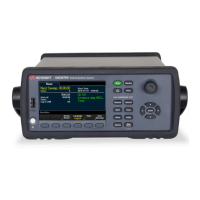CONFigure:{FRESistance|RESistance} [{<range>|AUTO|MIN|MAX|DEF},
[{<resolution>|MIN|MAX|DEF},]] (@<ch_list>)
RESistance measurements only supported on DAQM900A, DAQM901A, DAQM902A, and DAQM908A mul-
tiplexer modules.
FRESistance measurements only supported on DAQM900A, DAQM901A, and DAQM902A multiplexer mod-
ules.
Configures the channels for 2-wire and 4-wire resistance measurements, but they do not initiate the scan. This com-
mand redefines the scan list.
The CONFigure command does not place the instrument in the "wait-for-trigger" state. Use the INITiate or READ?
command in conjunction with CONFigure to place the instrument in the "wait-for-trigger" state.
Parameter Typical return
<range>
RESistance: { 100 Ω | 1 kΩ | 10 kΩ | 100 kΩ | 1 MΩ | 10 MΩ | 100 MΩ | 1 GΩ }.
Default: 1 kΩ
FRESistance: { 100 Ω | 1 kΩ | 10 kΩ | 100 kΩ | 1 MΩ | 10 MΩ | 100 MΩ | 1 GΩ }.
Default: 1 kΩ
<resolution> = 1 PLC (0.000003 x Range)
(none)
Configure 2-wire measurements on channel 101. Then read the measurement.
CONF:RES (@101)
READ?
Typical Response: +1.99409115E+02
–
For the FRESistance version of this command, channel n is paired with channel n+10 (DAQM900A or
DAQM901A) or n+8 (DAQM902A) to provide source and sense connections.
– When you specify a range of channels with this command, any channels that are invalid will be ignored (no error
will be generated) but the selected function must be valid for at least one channel in the range, or an error will be
generated.
–
You can allow the instrument to automatically select the measurement range using autoranging or you can
select a fixed range using manual ranging. Autoranging is convenient because the instrument decides which
range to use for each measurement based on the input signal. For fastest scanning operation, use manual ran-
ging on each measurement (some additional time is required for autoranging since the instrument has to make a
range selection).
– If you select autoranging (by specifying "AUTO" or "DEF"), an error will be generated if you specify a discrete value
for the <resolution> parameter. When autoranging is combined with a discrete resolution, the instrument can-
not accurately resolve the integration time (especially if the input signal is continuously changing). If your applic-
ation requires autoranging, be sure to specify "AUTO" for the <resolution> parameter, or omit the parameter
from the command and use the [SENSe:]VOLTage[:DC]NPLC command to specify the desired integration time.
Keysight DAQ970A/DAQ973A Programming Guide 97
2 SCPI Programming

